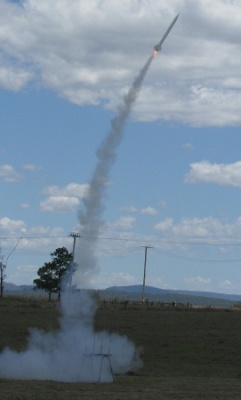Get a few cheap garbage bags, some sticky tape and some string, fill balloon with air, put in the sun and you have a Solar balloon.
 |
| Tetroon shaped Solar Baloon |
I found another site that had a DIY section and it looked pretty straight forward so decided that I would give it a try. My first attempt was with a garbage bag that we had in the cupboard to put rubbish in, this was not a success. This bag was too high quality, so the plastic was not thin, so the bag weighed too much and any lift generated was not able to lift the garbage bag. This garbage bag was now used to for its intended purpose of holding rubbish.
Upon further reading I learnt that the cheaper garbage bags are better for this sort of thing as they are thinner and thus weigh less. This makes them pretty useless as a garbage bag, but great for a Solar Balloon. So I headed to the local Coles and Woolworths and looked for the home brand Garbage bags, we bought 4 different types and they have been summarized in the table below.
The Coles home brand Wheelie bin garbage bags were the best bags, and cost about AUD $1 for a pack of four of them from Coles.
HOW DOES IT WORK ?
Basically we are looking for the greatest volume to weight ratio, as that means that there is a lot of air inside the balloon to be warmed up, with the least weight for the balloon to lift.How a solar balloon works is the black plastic absorbs the energy from sunlight which will heat the air inside which reduces the density of the air, making it lighter than the surrounding air which creates lift so the balloon will rise. This is similar in concept to a hot air balloon, just that a hot air balloon, the energy is provided by a gas burner, rather than from the sun.
These balloons work better with cold or cool air and bright direct sun, so that there is a greater difference between the heated air inside the balloon and the external 'cooler' air. I have tried them both in Summer and Winter and was able to get it working under hot and cold temperatures. The balloons fly best in the morning when there is less wind and when the air has not had much time to warm up, I have tried a few times in the afternoon and never been able to get the balloon aloft. It will take about 15 minutes for the air to warm up inside the balloon. Direct sunlight works much better than cloudy or indirect sunlight.
 |
| Cylinder Solar Balloon with Sun flare :) |
The black plastic was 11'C higher in temperature than the surrounding air.
There is not a very large amount of lift produced but their is sufficient for the balloon to rise fairly rapidly into the air. If you build a large enough balloon it can create enough lift to lift a human. Due to their low lift capacity and large surface area these solar balloons are very prone to being blown around by the wind, when flying one of these balloons you need to have a fairly windless day and walk with the balloon following the wind so that you can stay underneath the balloon, to achieve maximum height. If you stand still and let the balloon drift on a tether the wind will blow the balloon down to the ground as the maximum length of the tether is reached.
I always fly the balloon with an attached tether as it is illegal to fly something over 400 foot high without prior CASA approval, and where I fly these balloons is under the flight path from a small aircraft and helicopter airport. I use a kite string for the tether, which works well.You can see in the following video that the string is 'flicking' this is as it is unwinding from the kite holder
BUILD ONE YOURSELF
This is something that is very easy to build, something that you can build with your kids and is very cheap to test, it just needs some string, some sticky tape, and some cheap garbage bags. The garbage bags that I use cost me about 25 cents ($AUD) each, so the balloon I flew this morning cost me 75 cents. Something great to keep the kids amused one morning this holidays and teach them about some basic science and aerospace.I have noticed that people do get rather curious about what I am doing when I have about. 600 liter 4 meter long black tube 60 foot in the air, and will often, come up to me and talk to me about it.
I have heard of people releasing these balloons and achieving heights of 20,000 feet, one day when I get time, I will look into releasing one with telemetry and an altimeter to see how high and how far it goes, but I will need to be nowhere near controlled airspace to be allowed to do this.
There are two shapes that most solar balloons tend to be either a long cylinder, or a tetroon, I recommend starting with the long cylinder shape first as they are the easiest to make and will only take about 30 minutes to put together, the tetroons takes about two hours to make is a fair bit harder to make, but is a more efficient shape (larger volume for the same amount of garbage bags). Try not to use too much sticky tape as that is just added unnecessary weight.
Give it a try with your kids these holidays, an easy fun experiment that will teach them something.





.jpg)
